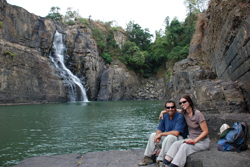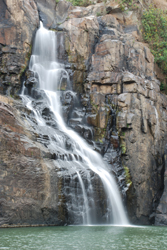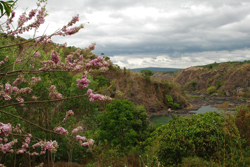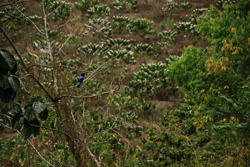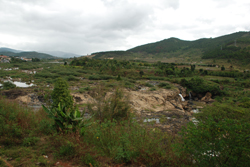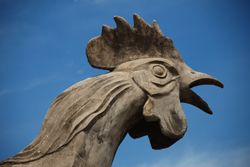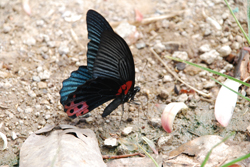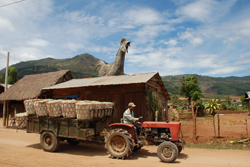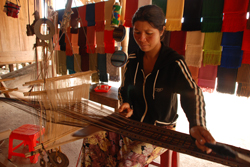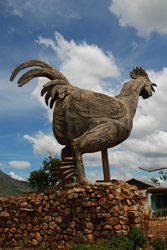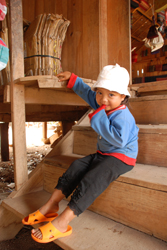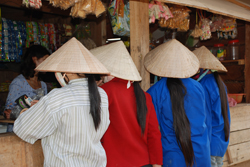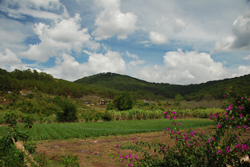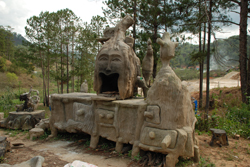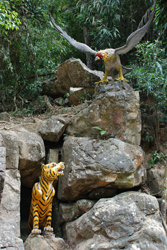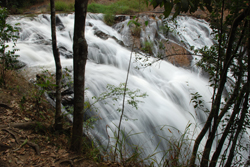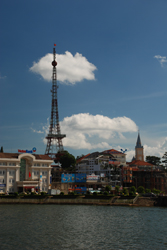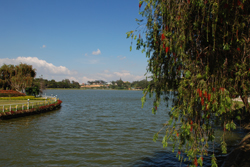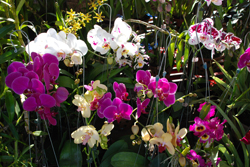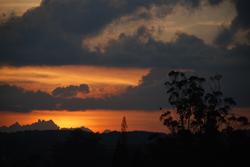Yum-Yums at the Pongour Falls
28 February, 2009, 02:34 am in "Vietnam"
Pongour Falls is 50 km from Dalat—-a rather uninteresting ride repeating 30 km of the highway we were on for the Chicken Village. The street got crowded as we went through a town. I worried maybe there was a road we should turn off somewhere since the only directions we had were to go down the road to Saigon.
We stopped and asked a man. First he pointed back where we came from (there had been a turn off to some different falls). Then he seemed to change his mind and pointed the other way giving detailed directions (or what was assumed were detailed directions in Vietnamese. He drew a map-- 500 meters to a paved road on the right (pointed to a pavement and stomped showing it was hard). The falls were 6 km up that road. I thanked him in Vietnamese and he gave us a big smile. The turn off was probably more than 500 meters but aside from that his directions were perfect. There was also a big sign pointing the way-- a pleasant surprise.
The road became quiet and rural with fields on either side and a section covered with cow shit. We wondered if they kept the cows on the road at night.
The falls had no concrete sculptures to our relief. A forested path led past souvenir stalls and little cafes--though all pretty dead-- down to the falls. It was so empty I began wondering if the falls were there. I'd heard they were greatly reduced during the dry season-- maybe they were completely dry. A woman beckoned us to look at the view from her cafe. It looked down to a patch of river between hills but we didn't see any waterfalls.
As we approached the end of the trail, we heard the sound of a falls but not one as big as the photos. Pongour is the largest falls in the region. The falls were, due to the dry season, made up of two falls: one wide and cascading down terraces of rock and a narrow falls on the other side. Between the two were more rock terraces which during the rainy season would be covered with rushing water connecting the 2 falls into one huge one.
We stopped and asked a man. First he pointed back where we came from (there had been a turn off to some different falls). Then he seemed to change his mind and pointed the other way giving detailed directions (or what was assumed were detailed directions in Vietnamese. He drew a map-- 500 meters to a paved road on the right (pointed to a pavement and stomped showing it was hard). The falls were 6 km up that road. I thanked him in Vietnamese and he gave us a big smile. The turn off was probably more than 500 meters but aside from that his directions were perfect. There was also a big sign pointing the way-- a pleasant surprise.
The road became quiet and rural with fields on either side and a section covered with cow shit. We wondered if they kept the cows on the road at night.
The falls had no concrete sculptures to our relief. A forested path led past souvenir stalls and little cafes--though all pretty dead-- down to the falls. It was so empty I began wondering if the falls were there. I'd heard they were greatly reduced during the dry season-- maybe they were completely dry. A woman beckoned us to look at the view from her cafe. It looked down to a patch of river between hills but we didn't see any waterfalls.
As we approached the end of the trail, we heard the sound of a falls but not one as big as the photos. Pongour is the largest falls in the region. The falls were, due to the dry season, made up of two falls: one wide and cascading down terraces of rock and a narrow falls on the other side. Between the two were more rock terraces which during the rainy season would be covered with rushing water connecting the 2 falls into one huge one.
It was a peaceful spot (with the exception of a loud group of young people banging drums and singing). The falls formed a pool that fluctuated between emerald and olive. The air felt hot and dry, though a bit of rain soon followed.
As we headed back up the path, Rowshan commented that the group was behaving like the Island of Yum-Yums.
“What?” I asked.
“Don't you know what a Yum-Yum is in Turkish?” he asked.
“No”
“People who eat other people”
“Oh! Cannibals!”
We stopped at the view cafe and had delicious coffee with milk. The view had the added benefit of birds-- green, blue, yellow, and black zipping between the trees and calling out their songs. The hills rose green beyond the river and a tree with flowers like cotton candy added a touch of pink.
As we headed back up the path, Rowshan commented that the group was behaving like the Island of Yum-Yums.
“What?” I asked.
“Don't you know what a Yum-Yum is in Turkish?” he asked.
“No”
“People who eat other people”
“Oh! Cannibals!”
We stopped at the view cafe and had delicious coffee with milk. The view had the added benefit of birds-- green, blue, yellow, and black zipping between the trees and calling out their songs. The hills rose green beyond the river and a tree with flowers like cotton candy added a touch of pink.
We headed back stopping to look at a view of the other falls from the busy town. We fondly watched for the chicken statue from the highway and chanted, “Chicken! Chicken!” when we saw it. Rowshan commented how it was so much better than just having bunches of political figure statues.
Searching for the Chicken Village
27 February, 2009, 02:34 am in "Vietnam"
We rented a motor scooter and headed out of town to find the giant chicken-- not a living one but a statue-- located in the Chicken Village. We climbed hills covered with pine trees which looked down over fields of vegetables. Purple morning glories grew by the road.
We didn't have directions except for a small map of the Dalat area with the words “Chicken Village 18km” and an arrow pointing down a road off the map. This could mean the village was on that road or it could mean it was down another road leading off of it. We hoped we'd see the giant chicken from a distance and be guided in that way. The LP book said the Chicken Village's name was “Lang Dinh An”. I saw a sign on the road that said something in Vietnamese and “Dinh An”, so we asked at a cafe. Of course, no one spoke English and we don't know any Vietnamese so we mimed something large and did a chicken impersonation (imchickenation) complete with clucking noises to express “Chicken”. A woman seemed to say we should take the left branch on the road.
The road split and the branch to the right went under the highway going to the left. The left road which we took ended up going straight onto the highway, past a “no motorcycle” sign. We continued on the highway noticing several other motorcyclists ignored the sign as well. Scanning both sides of the road, we searched for a chicken rising above the houses around it. At a bit past the 18th km from Dalat I saw the statue off a ways to the left. At this point we realized there didn't seem to be any offramps from the highway. We probably went 10 km more before we found a split in the divide (complete with no U-turn sign) where we could turn around and head back. We found a dirt path which seemed to be a homemade motorbike offramp to the village, but the path was too rough and rocky for our scooter (which was low to the ground), so we had to get back on the highway. A little farther on we saw another dirt road “offramp”. It seemed to lead to a better quality road that ran parallel to the highway.
We didn't have directions except for a small map of the Dalat area with the words “Chicken Village 18km” and an arrow pointing down a road off the map. This could mean the village was on that road or it could mean it was down another road leading off of it. We hoped we'd see the giant chicken from a distance and be guided in that way. The LP book said the Chicken Village's name was “Lang Dinh An”. I saw a sign on the road that said something in Vietnamese and “Dinh An”, so we asked at a cafe. Of course, no one spoke English and we don't know any Vietnamese so we mimed something large and did a chicken impersonation (imchickenation) complete with clucking noises to express “Chicken”. A woman seemed to say we should take the left branch on the road.
The road split and the branch to the right went under the highway going to the left. The left road which we took ended up going straight onto the highway, past a “no motorcycle” sign. We continued on the highway noticing several other motorcyclists ignored the sign as well. Scanning both sides of the road, we searched for a chicken rising above the houses around it. At a bit past the 18th km from Dalat I saw the statue off a ways to the left. At this point we realized there didn't seem to be any offramps from the highway. We probably went 10 km more before we found a split in the divide (complete with no U-turn sign) where we could turn around and head back. We found a dirt path which seemed to be a homemade motorbike offramp to the village, but the path was too rough and rocky for our scooter (which was low to the ground), so we had to get back on the highway. A little farther on we saw another dirt road “offramp”. It seemed to lead to a better quality road that ran parallel to the highway.
The road seemed to get better and to our surprise a local spoke English decently and confirmed that it led to a paved road which after 5km would bring us to the Chicken Village on the left. “Look for the big chicken,” he said. 5 km up the road we still didn't see the chicken. We went a bit further and asked a woman. I said, “Ga” (chicken) and made “big” gestures. She said, “Ga!” and pointed further. We continued on and eventually came to the street we'd missed by getting on the highway. I had been congratulating myself on what I had thought was a successful example of communication but was disappointed to see she evidently had no idea what I had been asking and thought we were looking for the highway.
We turned back and asked some kids making clucking noises in case, as it seems, I didn't get the tone right for “ga” and was actually saying something completely different. (Vietnamese is a tonal language so one word, for example “ga” can have several completely different meanings depending on how it is said... with a high tone, a falling tone, rising tone, etc.) One gave us some detailed directions in Vietnamese but his gestures seemed to suggest that we were going in the right direction and would find the chicken on our right. Soon we were almost back to where we had left the dirt road. So we turned and headed back. We asked a woman who spoke some English. She said go 1 km and it was down a road to the left. As further clarification she said the road was by a house. Not the most helpful of directions since most of the buildings around were either houses or shops or a combination of the two. This time between the 18 and 19km Dalat signs I asked a man. He gestured to take a road that went parallel to the road we were on, turn left then left again (back tracking). We did this and finally I saw the chicken statue through the trees. It is larger than the houses around it, and carefully sculpted from concrete.
We turned back and asked some kids making clucking noises in case, as it seems, I didn't get the tone right for “ga” and was actually saying something completely different. (Vietnamese is a tonal language so one word, for example “ga” can have several completely different meanings depending on how it is said... with a high tone, a falling tone, rising tone, etc.) One gave us some detailed directions in Vietnamese but his gestures seemed to suggest that we were going in the right direction and would find the chicken on our right. Soon we were almost back to where we had left the dirt road. So we turned and headed back. We asked a woman who spoke some English. She said go 1 km and it was down a road to the left. As further clarification she said the road was by a house. Not the most helpful of directions since most of the buildings around were either houses or shops or a combination of the two. This time between the 18 and 19km Dalat signs I asked a man. He gestured to take a road that went parallel to the road we were on, turn left then left again (back tracking). We did this and finally I saw the chicken statue through the trees. It is larger than the houses around it, and carefully sculpted from concrete.
A woman from a weaving shop across from the chicken greeted us in English asking where we were from and inviting us into her shop. We said we'd come have a look after paying homage to the giant chicken. We parked by her store under a tree occupied by an unfortunate looking monkey with a collar attached to a chain which was attached to the tree. The monkey appeared to be trying to hang himself, and swung from the chain around his neck. Eventually either he found his efforts unsuccessful or he had some epiphany and decided life was worth living after all and pulled himself back on the branch.
As Rowshan was busy taking chicken photos, I went to look at the shop. It was in a simple wood house and had a long narrow loom set up in the middle. The woman, Karol, complimented me as I walked in, “You have a beautiful nose. Its long”. I thought this an odd compliment but I did notice her nose was little and flat making mine in comparison, quite long. I liked her friendly manner even if it was only to get me into her store.
Karol served tea and showed me how she wove as well as some of the pieces. “Half cotton, half silk. You don't have to buy. Just look.” She showed me some cute round zipped bags that when unzipped became backpacks. There were some other bags as well I admired the practicality of their design. I asked where the designs came from and she said they were designed in the village and the head of the village chose what would be produced. The weaving was done by people in the village as well as other villages by Chal, K'Ho, Ma and Cham ethnic groups. The chicken village residents were mostly K'Ho. I asked her why the chicken statue was made. “You don't know the story?” she asked. “There is a story in this town.” She told me how in the village girls choose their husband instead of the boys choosing the girl. Then the girl had to ask the boys family how much of a dowry she must provide. In the old days a husband could be bought for a chicken (Now, however, the price has gone up to a water buffalo.”
As Rowshan was busy taking chicken photos, I went to look at the shop. It was in a simple wood house and had a long narrow loom set up in the middle. The woman, Karol, complimented me as I walked in, “You have a beautiful nose. Its long”. I thought this an odd compliment but I did notice her nose was little and flat making mine in comparison, quite long. I liked her friendly manner even if it was only to get me into her store.
Karol served tea and showed me how she wove as well as some of the pieces. “Half cotton, half silk. You don't have to buy. Just look.” She showed me some cute round zipped bags that when unzipped became backpacks. There were some other bags as well I admired the practicality of their design. I asked where the designs came from and she said they were designed in the village and the head of the village chose what would be produced. The weaving was done by people in the village as well as other villages by Chal, K'Ho, Ma and Cham ethnic groups. The chicken village residents were mostly K'Ho. I asked her why the chicken statue was made. “You don't know the story?” she asked. “There is a story in this town.” She told me how in the village girls choose their husband instead of the boys choosing the girl. Then the girl had to ask the boys family how much of a dowry she must provide. In the old days a husband could be bought for a chicken (Now, however, the price has gone up to a water buffalo.”
A girl from a poor family was in love with a boy from a wealthier family. She asked the family what the price was. The boy's family said she had to give them a chicken with nine spurs (The statue has 9 spurs-- 4 on one leg, 5 on the other.) The girl realized they said this because they didn't like her and a 9 spurred rooster would be very expensive and hard to find. She went to the forest in the hills to try to find one and died. For this reason the town made a statue in her memory. I'm not sure if this is the real reason or just something made up for tourists. The rooster statue isn't that old and perhaps the real reason it was built was to lure tourists out. Anyway, I told her Rowshan's giant chicken story. She was surprised when I said he was my husband of 8 years. “A woman married 8 years here would have 8 children-- one each year.
She also told me how in the village the men worked in the fields but the women kept the money and the men had to ask the women for money when they needed it. The groom would move in with the bride's family and take the bride's family name. I thought women having control over the money was wise.
I enjoyed talking to Karol and was happy to purchase a clever little bag (perfect size for my notebook, a pen, local money and other useful things) and a shirt for Rowshan.
We stopped by a pho place on the main road for lunch. After numerous communication difficulties, we ordered 2 bowls of pho and the woman told us to have a seat. Then we ordered a couple glasses of coffee. The coffee came but the woman showed no signs of making pho. After waiting a bit we asked her again and had to completely repeat our previous conversation-- checking price and ordering--wondering why she asked us to sit down if we hadn't actually ordered the first time. A mechanic from next door and an older woman were also hanging out at the cafe-- not eating or drinking. I think they were there to watch TV or perhaps us. Football was on TV so Rowshan decided to try a conversation with the man using the universal language of football. He said, “football” (with kicking motions). Then tried to evoke a response saying “Vietnam” and “Thailand” since Vietnam had recently beat Thailand. The man seemed to completely misunderstand and perhaps thought Rowshan didn't like football so he changed the station. The other station's picture was wavy and bad. He looked at it sorrowfully as if trying to please Rowshan by changing the station but finding no other station that worked. We reassured him “football Good!” and eventually convinced him to change it back.
We drove up another road just to look at the forests and fields. Turning back we stopped at a strange concrete stone structure with faces and log shapes as well as a toothbrush holder. There were also several concrete chairs. I was reminded of rural areas in the US where people carve sculptures of bears and Indian chiefs from big logs.
We drove up another road just to look at the forests and fields. Turning back we stopped at a strange concrete stone structure with faces and log shapes as well as a toothbrush holder. There were also several concrete chairs. I was reminded of rural areas in the US where people carve sculptures of bears and Indian chiefs from big logs.
As we were puzzling over this, 2 French girls drove up asking us if we knew where the Chicken Village was. They'd been searching for about 2 hours. We gave them instructions and then headed to the Datanla falls. The parking lot had several tour buses and lots of motorcycles. The ticket booth was a concrete sculpture of what looked like two basket-woven cups. There was a gold statue of a woman and baby by the entrance arch and another ticket booth for a roller coaster ride to the falls.
“This does not bode well,” I guessed. We took the set of concrete steps through a forest passing the winding track of the roller coaster and manicured gardens. The falls were one of those places that make one sorry to be paying admission once you see what the money is going to. The falls were pretty but a path made of conc
rete tree stumps led to a concrete bridge full of people posing for photos. Next to the falls there was a concrete tiger and eagle.
“This does not bode well,” I guessed. We took the set of concrete steps through a forest passing the winding track of the roller coaster and manicured gardens. The falls were one of those places that make one sorry to be paying admission once you see what the money is going to. The falls were pretty but a path made of conc
rete tree stumps led to a concrete bridge full of people posing for photos. Next to the falls there was a concrete tiger and eagle.
There were souvenir shops, and a place to rent minority clothing to wear for photos. We climbed a path up to the top of the falls and found a little bit of peace before groups of young guys puffing cigarettes reached there. Disappointed at how people can't seem to appreciate natural beauty for what it is and instead feel they must cover it with concrete, we walked back up the hill (passing the young wheezing cigarette smoking locals).
Dalat: A Giant Miniature Golf Course
26 February, 2009, 03:34 am in "Vietnam"
The abundance of manicured lawns and parks, kitchy buildings, lake with swan boats, and cheerful summer vacation architecture makes Dalat seem like a giant miniature golf course. Any moment I expected to see a giant golf ball come rolling between the legs of the the radio tower which would light up with flashing colors and electronic music. It is a mountain resort town and does have a pretty location-- surrounded by hills and trees. It's just, as seems to happen with many mountain resort places, a bit too polished and “prettified” as if the town wants to separate itself from the beautiful nature around it and present the visiting honeymooners and tourists a marshmallowized version of paradise.
The first part of the bus ride was torture. As usual the locals started puking within 15 minutes of leaving town-- before the road even got bad. Then the road became a potholed mess. The driver would accelerate as he swerved around them. If he couldn't avoid them, the bus would rock like a ship in a storm as it went over them. I had to pop a motion sickness pill to avoid puking. Fortunately, about ½ way to Dalat, the road became smooth and since we were ascending, the driver had to go slow and couldn't veer around the bends.
As we got closer to Dalat, I was happy to see more green pine trees and shady patches of forest. We walked to the lake going by a big church (at the top of a slope, just like in a miniature golf course).
Later we found further evidence that Dalat was designed to look like a miniature golf course. We found a restaurant with a red windmill (Moulin Rouge)built into it as well as an entrance to somewhere designed to look like a castle.
As we got closer to Dalat, I was happy to see more green pine trees and shady patches of forest. We walked to the lake going by a big church (at the top of a slope, just like in a miniature golf course).
Later we found further evidence that Dalat was designed to look like a miniature golf course. We found a restaurant with a red windmill (Moulin Rouge)built into it as well as an entrance to somewhere designed to look like a castle.
Powered by My Blog 1.69. Copyright 2003-2006 FuzzyMonkey.net.
Created by the scripting wizards at FuzzyMonkey.net..
(Code modified by Rowshan Dowlatabadi)
Created by the scripting wizards at FuzzyMonkey.net..
(Code modified by Rowshan Dowlatabadi)


